A distinguishing feature separating species is the number of digits on their hind feet. Seems about 1/3 of the species have 4, and 2/3 have 5.
In the Mono Basin, there's 2, maybe 3, species of k-rats, and all should have 5 rear toes - Dipodomys ordii, panamintinus and maybe microps (but probably not).
So, I thought I'd try some short-distance overnight sets with my 10 mega pixel Pentax homebrew, to see if I could resolve that infamous fifth appendage.
Here's the cam trap's photos...

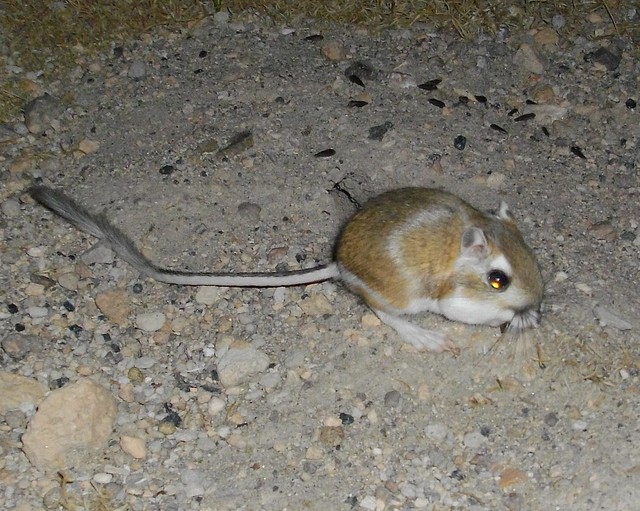
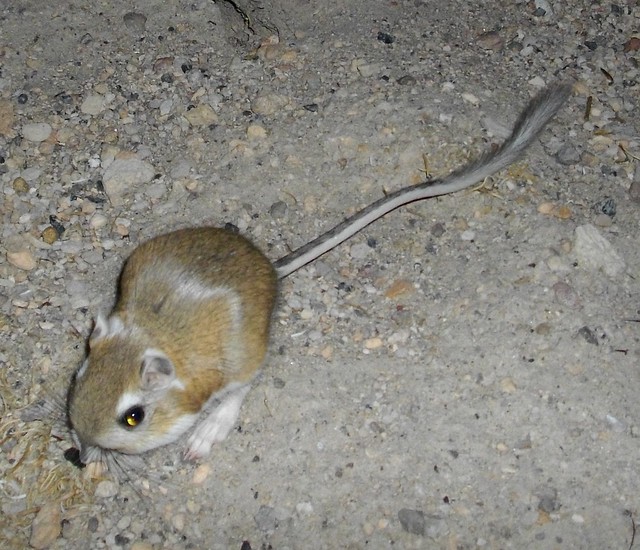
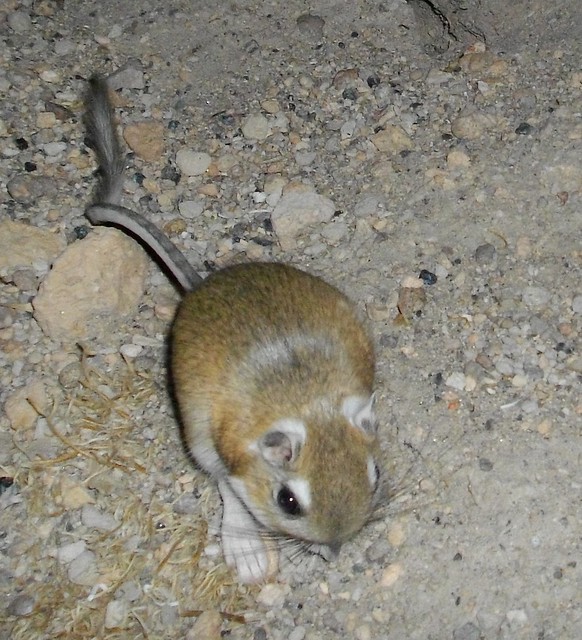

Dunno about you, but I'm not seeing any 5th toes.
Which led me to check with CDFG biologist-bud Craig, at the Chimineas Ranch, who's had many a k-rat species in-hand. He reported that, yes indeed, the 5th toe is a tiny, interior dew-claw on all of the species, and it would be a surprise to be able to see it in a photo.
Comforting to know the cam traps are not to blame, but it does still leave us in the lurch on the specific epithet of the Dipodomys above.
So, let's see if we can sort it out. The 2 most likely species are ordii and panamintinus - Ord's and Panamint kangaroo rats. Dipodomys microps, the Chisel-toothed, is also a sagebrush scrub inhabiting k-rat of the east side, but I'm pretty sure its range ends south of the Mono Basin.
Collating size, pattern and color descriptions from multiple references, here's what I find:
| Feature | Dipodomys ordii | Dipodomys panamintinus |
| Back | yellowish buff w/ a few black hairs down center | ashy gray to dark brown |
| Sides | buff sides and white belly, diagonal line across hip | cinnamon sides and white belly, diagonal line across hip |
| Face | white spot above eye and behind ear, blackened whisker base | white eyebrow, white spot at base of each ear, pale cheeks |
| Feet | 5 toes on extremely long hind feet | 5 toes on normal size hind feet |
| Tail | long, tufted tail with dark dorsal and ventral stripes | tail over 60% of length and strongly crested with dark hairs dorsally, ventrally and at tip |
Not exactly apple-to-apples in their descriptions of the key characters, but not bad. Makes me lean towards ordii for our foraging friend, but just barely.
What about you? Anyone out there have either species in-hand before?
Whichever - they sure are adorable. I gotta say that whoever gave them the moniker "kangaroo rats" really did 'em a disservice. "Rat" evokes such a negative image, and these little joys are nothing of the sort. Should have been named "kangaroo gerbils" for their gentleness.
Here's a few Dipodomys heermanni I had in-hand on the Chimineas Ranch - the first with his cheek pouches full of seed from the live trap, and proudly showing us those 5 toes that Heermann's also has on his furry feet. As Craig said - the 5th is a wee piggy, for sure:
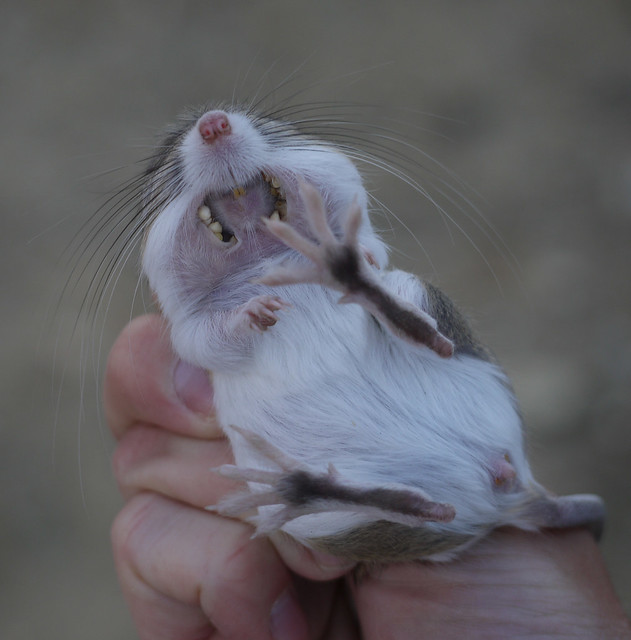
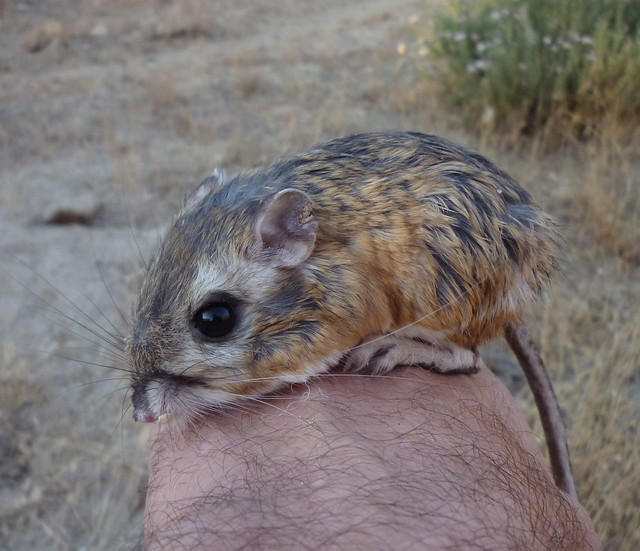

Adorable, absolutely adorable.
====
References:
- E. W. Jameson, Jr., and Hans J. Peeters, UCPress - Mammals of California
- Tamara Eder - Mammals of California
- Smithsonian National Museum of Natural History - Panamint Kangaroo Rat
- Smithsonian National Museum of Natural History - Ord's Kangaroo Rat
- Smithsonian National Museum of Natural History - Heermann's Kangaroo Rat
- Wikipedia - Gerbil

i second your last line!!
ReplyDeleteThat photo with the cheek pouches full of seeds is priceless!
ReplyDeleteUsing the key you posted I came up with the exact opposite as you, just barely. But then looking at more images (assuming they are correctly keyed out) it appears you are right. The eye-brow on panamintinus seems to be thinner like an actual eye-brow rather than the half circle shape of ordii. The white above the eye on guy in your photos does look more ordii. What is the defining characteristic that separates the two species? Teeth or something molecular?
ReplyDeleteHa! That's funny Jake. My choice was of course also guided by the illustrations in my books and the photos I saw online, in which you can see the difference between "white spot" and "white eyebrow." I also thought them more yellowish buff than cinnamon ashy gray.
ReplyDeleteThe defining character in the Jameson & Peeters key for ordii: "hind foot usually less than 44mm; total length less than 280mm." And panamintinus are "usually" more on both accounts. But it's not like ordii is small and panamintinus huge - their comparative total length ranges are 208-281mm, and 285-334mm. I.e., panamintinus is generally a few centimeters longer. Argh.
Put a ruler down on the ground next time and maybe you will get really really lucky and one will measure itself.
ReplyDeleteHmmm... ruler huh? Total length includes the tail - do you think I could coax them into stretching out with their tail straight? :)
ReplyDeleteI'm thinking I might just live trap them and do the measurements. Perhaps if I can get enough pics of confirmed ordii and panamintinus, we'll be able to see enough visual diffs to tell them apart thereafter.
The foot measurement might be possible on a camera trap, but yes live traps would probably be a better way to go.
ReplyDeleteDid some reading and it seems D. panamintinus may be more prevalent in the pinyon pine belt. You might have more luck finding them at the interface between pinyon habitat and sage-steppe. But MVZ has records in Adobe Valley so there is likely some overlap. BTW Grinnell wrote a very detailed monograph on k-rats with in-depth measurements and pelage descriptions. There are even drawings of the faces of each k-rat. It's "A geographical study of the kangaroo rat of California" and it's on Google Books.
ReplyDeleteI'm wondering if one could study Dipo. tracks (if you set up a track plate, to get nice ones) and start to measure the tracks and get to foot length. Just wondering 'cause I am a HUGE fan of NOT physically trapping and handling animals whenever possible. How about a hair snag and then check their DNA?
ReplyDeleteAnyhow, YES, they are SUCH beautiful creatures, so charming. So many GREAT photograph! Nice, glossy coat. =)
Thanks for sharing!
Excellent info and references Craig (dr_f) - thanks much.
ReplyDeleteBB - yes, as I think I've mentioned, the whole idea of these experiments is to try and build data and photos that will allow ID w/o live trapping. But to do that, we need to get solid confirmations on the IDs. Foot tracks might work, but I think they tend to hop on the front of their hind feet, so may not leave a good mark. Plus, they're quite lightweight, and foot size will only work for some species. DNA testing is definitely the future, but as of today, it costs hundreds of thousands of dollars to create a reference set and then do DNA tests for comparisons. If you're rich and want to set up a lab, let me know... :)
I also would be happy to run Randomtruth's said DNA lab if anyone out there wants to fund it.
ReplyDelete